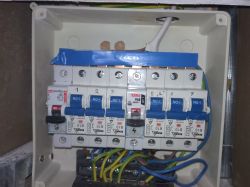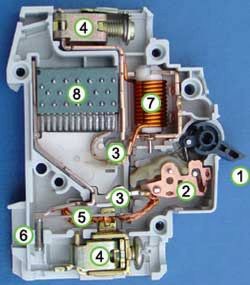Hello,
Recently, I have noticed a strange noise coming from the fuse box. I would like to add that nothing has been changed for a long time and nothing like this has happened before.
We live in an old building, so for sure the electrical installation is very poorly done and I know it. We did not do this installation ourselves.
In the current situation (state of the epidemic), I do not want to call an electrician without a serious problem, so maybe I will be able to do something myself (e.g. just replace one of the fuses)
The case is as follows:
I have seven separate fuses (circuits)
1 - Fuse B10 - Lights and bell
2 - Fuse B10 - Sockets
3 - Fuse B10 - Sockets
4 - Fuse B16 - Oven, hood, dishwasher
5 - Fuse B10 - Refrigerator
6 - Fuse B10 - Sockets in the bathroom (including the connected Washing machine)
7 - Fuse B10 - bathroom lights
G - Main fuse that cuts off the current in all of the above - C16
When I turn on the oven, while the heater is on, you can hear such a strange "buzzing / humming" from the box, when I turn on the dishwasher at the same time, the humming noise becomes louder. At first I thought that the problem was in the fuse on circuit No. 4, but yesterday I noticed that when the washing machine itself is working, I also hear a soft humming noise as long as the heater is working (the washing machine is on circuit No. 6).
I think the problem is somewhere in this main fuse (wrongly selected, burns out?)
I will be able to solve it myself or is an electrician's visit necessary?
Thanks in advance for your help
Recently, I have noticed a strange noise coming from the fuse box. I would like to add that nothing has been changed for a long time and nothing like this has happened before.
We live in an old building, so for sure the electrical installation is very poorly done and I know it. We did not do this installation ourselves.
In the current situation (state of the epidemic), I do not want to call an electrician without a serious problem, so maybe I will be able to do something myself (e.g. just replace one of the fuses)
The case is as follows:
I have seven separate fuses (circuits)
1 - Fuse B10 - Lights and bell
2 - Fuse B10 - Sockets
3 - Fuse B10 - Sockets
4 - Fuse B16 - Oven, hood, dishwasher
5 - Fuse B10 - Refrigerator
6 - Fuse B10 - Sockets in the bathroom (including the connected Washing machine)
7 - Fuse B10 - bathroom lights
G - Main fuse that cuts off the current in all of the above - C16
When I turn on the oven, while the heater is on, you can hear such a strange "buzzing / humming" from the box, when I turn on the dishwasher at the same time, the humming noise becomes louder. At first I thought that the problem was in the fuse on circuit No. 4, but yesterday I noticed that when the washing machine itself is working, I also hear a soft humming noise as long as the heater is working (the washing machine is on circuit No. 6).
I think the problem is somewhere in this main fuse (wrongly selected, burns out?)
I will be able to solve it myself or is an electrician's visit necessary?
Thanks in advance for your help




